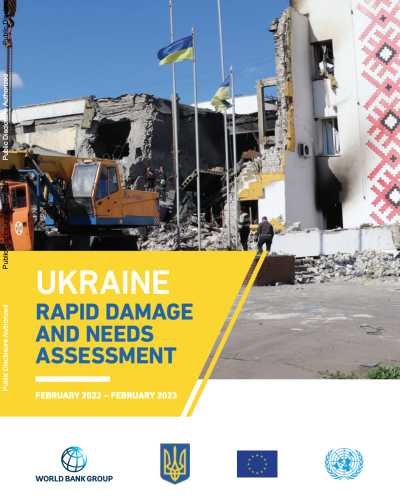Ukraine: Rapid Damage and Needs Assessment

This Rapid Damage and Needs Assessment (RDNA2) is part of an ongoing effort—undertaken jointly by the World Bank, the Government of Ukraine, the European Commission, and the United Nations, and supported by other partners—to take stock of Ukraine’s damage and losses from Russia’s invasion. Just as importantly, it aims to assess the scale of economic and social needs for Ukraine’s survival during the war and its prospering afterward.
Considering a full year of war, as of February 24, 2023, direct damage in Ukraine has reached over US$135 billion, with housing, transport, energy, and commerce and industry the most affected sectors. Damage is concentrated in the frontline oblasts, particularly Donetska, Kharkivska, Luhanska, Zaporizka, Khersonska, Mykolaivska, and in oblasts that were brought back under government control, such as Kyivska and Chernihivska. Disruptions to economic flows and production, as well as additional expenses associated with the war, are collectively measured as losses and amount to some US$290 billion. Ukraine’s gross domestic product (GDP) shrank by 29.2 percent in 2022, and poverty increased from 5.5 percent to 24.1 percent in 2022 (based on the poverty line of US$6.85 per person per day).
Reconstruction and recovery needs, as of February 24, 2023, are estimated at about US$411 billion. Integrated into these needs are critical steps toward becoming a modern, low-carbon, disaster- and climate-resilient country that has aligned with European Union policies and standards in view of being ready to join the European Union, and where the population’s vulnerabilities are addressed and people live in prosperity. While the financing envelope is overwhelming, experience from other countries shows that a phased approach to reconstruction is critical.
The report also estimates the implementation priorities for 2023 at around US$14 billion. These are focused on the most urgent needs, including restoration of energy, housing, critical and social infrastructure, basic services for the most vulnerable, explosive hazard management, and private sector development. Around US$9 billion in direct government expenditure will lay the groundwork for a safe, prioritized, achievable, and efficient reconstruction and recovery. This will be complemented by investments by state-owned enterprises (SOEs) and support to sustain and catalyze the private sector, including de-risking investment and trade. While the government has already taken steps to meet some of these needs, this report identifies a need for an additional US$11 billion in financing, including around US$6 billion in further funding of the government budget and close to US$5 billion to facilitate critical investments by SOEs and the private sector.






